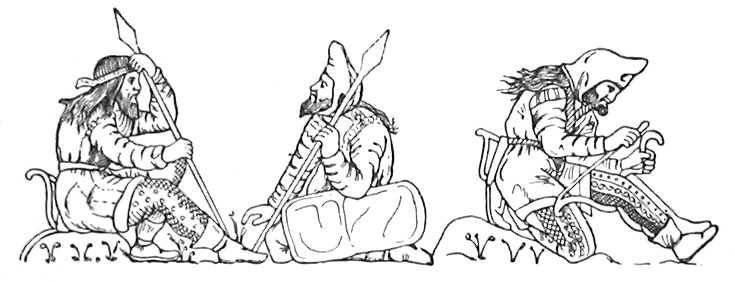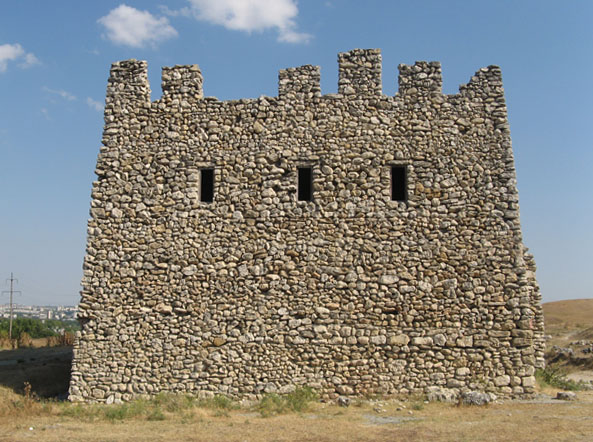|
Scythian Neapolis
Scythian Neapolis ( el, Σκυθική Νεάπολις), also known as Kermenchik, was a settlement that existed from the end of the 3rd century BC until the second half of the 3rd century AD and was previously considered a town of the Tauric Chersonesus (Crimea) and was mentioned by Strabo as being the fortress and palace where the Scythian kings resided. It is regarded as the capital of the Late Scythian Kingdom and the capital of ‘Great Scythia’. The archaeological ruins sit on the outskirts of the present-day Simferopol. This city was the centre of the Crimean Scythian tribes, led by Skilurus and Palacus. The town ruled over a small kingdom, covering the lands between the lower Dnieper river and Crimea. Between the end of the 4th c. BC to the beginning of the 3rd c. BC historians suggest that the Kizil-Koba culture occupied the area of Scythian Neapolis before any Scythian artefacts were found. Neapolis was destroyed halfway through the 3rd century AD by the Goths. This set ... [...More Info...] [...Related Items...] OR: [Wikipedia] [Google] [Baidu] |
Skilurus
Skilurus, or Scylurus, was a renowned Scythian king reigning during the 2nd century BC. His realm included the lower reaches of the Borysthenes and Hypanis, as well as the northern part of Crimea, where his capital, Scythian Neapolis, was situated. Skilurus ruled over the Tauri and controlled the ancient trade emporium of Pontic Olbia, where he minted coins. In order to gain advantage against Chersonesos, he allied himself with the Sarmatian tribe of Rhoxolani. In response, Chersonesos forged an alliance with Mithridates VI of Pontus. Skilurus died during a war against Mithridates, a decisive conflict for supremacy in the Pontic steppe. Soon after his death, the Scythians were defeated by Mithridates (ca. 108 BC). Either Skilurus or his son and successor Palacus were buried in a mausoleum at Scythian Neapolis; it was used from ca. 100 BC to ca. 100 AD. Pseudo-Plutarch, in ''Sayings of Kings and Commanders'', reports the following version of the Aesopic fable "The Old Man and his ... [...More Info...] [...Related Items...] OR: [Wikipedia] [Google] [Baidu] |
Knidos
Knidos or Cnidus (; grc-gre, Κνίδος, , , Knídos) was a Ancient Greece, Greek city in ancient Caria and part of the Dorian Hexapolis, in south-western Asia Minor, modern-day Turkey. It was situated on the Datça peninsula, which forms the southern side of the Sinus Ceramicus, now known as Gulf of Gökova. By the 4th century BC, Knidos was located at the site of modern Tekir, Turkey, Tekir, opposite Triopion Island. But earlier, it was probably at the site of modern Datça (at the half-way point of the peninsula). It was built partly on the mainland and partly on the Island of Triopion or Cape Krio. The debate about it being an island or cape is caused by the fact that in ancient times it was connected to the mainland by a causeway and bridge. Today the connection is formed by a narrow sandy isthmus. By means of the causeway the channel between island and mainland was formed into two harbours, of which the larger, or southern, was further enclosed by two strongly built mole ... [...More Info...] [...Related Items...] OR: [Wikipedia] [Google] [Baidu] |
Catacombs
Catacombs are man-made subterranean passageways for religious practice. Any chamber used as a burial place is a catacomb, although the word is most commonly associated with the Roman Empire. Etymology and history The first place to be referred to as ''catacombs'' was the system of underground tombs between the 2nd and 3rd milestones of the Appian Way in Rome, where the bodies of the apostles Peter and Paul, among others, were said to have been buried. The name of that place in Late Latin was L.L. fem. nom. pl. n. ''catacumbas'' (sing. ''catacumba'') a word of obscure origin, possibly deriving from a proper name or a derivation of the Latin phrase ''catatumbas'', "among the tombs". The word referred originally only to the Roman catacombs, but was extended by 1836 to refer to any subterranean receptacle of the dead, as in the 18th-century Paris catacombs. The ancient Christians carved the first catacombs from soft tufa rock. (ref)" (World Book Encyclopedia, page 296) All Roman ca ... [...More Info...] [...Related Items...] OR: [Wikipedia] [Google] [Baidu] |
Polytheists
Polytheism is the belief in multiple deities, which are usually assembled into a pantheon of gods and goddesses, along with their own religious sects and rituals. Polytheism is a type of theism. Within theism, it contrasts with monotheism, the belief in a singular God who is, in most cases, transcendent. In religions that accept polytheism, the different gods and goddesses may be representations of forces of nature or ancestral principles; they can be viewed either as autonomous or as aspects or emanations of a creator deity or transcendental absolute principle (monistic theologies), which manifests immanently in nature (panentheistic and pantheistic theologies). Polytheists do not always worship all the gods equally; they can be henotheists, specializing in the worship of one particular deity, or kathenotheists, worshiping different deities at different times. Polytheism was the typical form of religion before the development and spread of the Abrahamic religions of Juda ... [...More Info...] [...Related Items...] OR: [Wikipedia] [Google] [Baidu] |
Amphorae
An amphora (; grc, ἀμφορεύς, ''amphoreús''; English plural: amphorae or amphoras) is a type of container with a pointed bottom and characteristic shape and size which fit tightly (and therefore safely) against each other in storage rooms and packages, tied together with rope and delivered by land or sea. The size and shape have been determined from at least as early as the Neolithic Period. Amphorae were used in vast numbers for the transport and storage of various products, both liquid and dry, but mostly for wine. They are most often ceramic, but examples in metals and other materials have been found. Versions of the amphorae were one of many shapes used in Ancient Greek vase painting. The amphora complements a vase, the pithos, which makes available capacities between one-half and two and one-half tons. In contrast, the amphora holds under a half-ton, typically less than . The bodies of the two types have similar shapes. Where the pithos may have multiple small ... [...More Info...] [...Related Items...] OR: [Wikipedia] [Google] [Baidu] |
Horticulture
Horticulture is the branch of agriculture that deals with the art, science, technology, and business of plant cultivation. It includes the cultivation of fruits, vegetables, nuts, seeds, herbs, sprouts, mushrooms, algae, flowers, seaweeds and non-food crops such as grass and ornamental trees and plants. It also includes plant conservation, landscape restoration, landscape and garden design, construction, and maintenance, and arboriculture, ornamental trees and lawns. The study and practice of horticulture have been traced back thousands of years. Horticulture contributed to the transition from nomadic human communities to sedentary, or semi-sedentary, horticultural communities.von Hagen, V.W. (1957) The Ancient Sun Kingdoms Of The Americas. Ohio: The World Publishing Company Horticulture is divided into several categories which focus on the cultivation and processing of different types of plants and food items for specific purposes. In order to conserve the science of horticultur ... [...More Info...] [...Related Items...] OR: [Wikipedia] [Google] [Baidu] |
Viticulture
Viticulture (from the Latin word for ''vine'') or winegrowing (wine growing) is the cultivation and harvesting of grapes. It is a branch of the science of horticulture. While the native territory of ''Vitis vinifera'', the common grape vine, ranges from Western Europe to the Iran, Persian shores of the Caspian Sea, the vine has demonstrated high levels of adaptability to new environments, hence viticulture can be found on every continent except Antarctica. Duties of the viticulturist include monitoring and controlling Pest (organism), pests and Plant pathology, diseases, fertilizer, fertilizing, irrigation (wine), irrigation, canopy (grape), canopy Glossary of viticultural terms#Canopy management, management, monitoring fruit development and Typicity, characteristics, deciding when to harvest (wine), harvest, and vine pruning during the winter months. Viticulturists are often intimately involved with winemakers, because vineyard management and the resulting grape characteristics ... [...More Info...] [...Related Items...] OR: [Wikipedia] [Google] [Baidu] |
Black Sea Region
The Black Sea Region ( tr, Karadeniz Bölgesi) is a geographical region of Turkey. The largest city in the region is Samsun. Other big cities are Trabzon, Ordu, Tokat, Giresun, Rize, Amasya and Sinop. It is bordered by the Marmara Region to the west, the Central Anatolia Region to the south, the Eastern Anatolia Region to the southeast, the Republic of Georgia to the northeast, and the Black Sea to the north. Subdivision * Western Black Sea Section ( tr, Batı Karadeniz Bölümü) **Inner Western Black Sea Area ( tr, Batı Karadeniz Ardı Yöresi) **Küre Mountains Area ( tr, Küre Dağları Yöresi) * Central Black Sea Section ( tr, Orta Karadeniz Bölümü) ** Canik Mountains Area ( tr, Canik Dağları Yöresi) ** Inner Central Black Sea Area ( tr, Orta Karadeniz Ardı Yöresi) * Eastern Black Sea Section ( tr, Doğu Karadeniz Bölümü) ** Eastern Black Sea Coast Area ( tr, Doğu Karadeniz Ardı Yöresi) ** Upper Kelkit - Çoruh Gully ( tr, Yukarı Kelkit - Çoruh Olu ... [...More Info...] [...Related Items...] OR: [Wikipedia] [Google] [Baidu] |
Bosphorus
The Bosporus Strait (; grc, Βόσπορος ; tr, İstanbul Boğazı 'Istanbul strait', colloquially ''Boğaz'') or Bosphorus Strait is a natural strait and an internationally significant waterway located in Istanbul in northwestern Turkey. It forms part of the continental boundary between Asia and Europe, and divides Turkey by separating Anatolia from Thrace. It is the world's narrowest strait used for international navigation. Most of the shores of the Bosporus Strait, except for the area to the north, are heavily settled, with the city of Istanbul's metropolitan population of 17 million inhabitants extending inland from both banks. The Bosporus Strait and the Dardanelles Strait at the opposite end of the Sea of Marmara are together known as the Turkish Straits. Sections of the shore of the Bosporus in Istanbul have been reinforced with concrete or rubble and those sections of the Strait prone to deposition are periodically dredged. Name The name of the ... [...More Info...] [...Related Items...] OR: [Wikipedia] [Google] [Baidu] |
Sarmatian
The Sarmatians (; grc, Σαρμαται, Sarmatai; Latin: ) were a large confederation of Ancient Iranian peoples, ancient Eastern Iranian languages, Eastern Iranian peoples, Iranian Eurasian nomads, equestrian nomadic peoples of classical antiquity who dominated the Pontic–Caspian steppe, Pontic steppe from about the 3rd century BC to the 4th century AD. Originating in the central parts of the Eurasian Steppe, the Sarmatians were part of the wider Scythian cultures. They started migrating westward around the fourth and third centuries BC, coming to dominate the closely related Scythians by 200 BC. At their greatest reported extent, around 100 BC, these tribes ranged from the Vistula River to the mouth of the Danube and eastward to the Volga, bordering the shores of the Black Sea, Black and Caspian Sea, Caspian seas as well as the Caucasus to the south. In the first century AD, the Sarmatians began encroaching upon the Roman Empire in alliance with Germanic peoples, Germanic ... [...More Info...] [...Related Items...] OR: [Wikipedia] [Google] [Baidu] |






